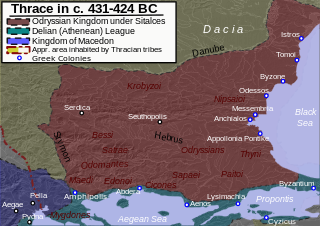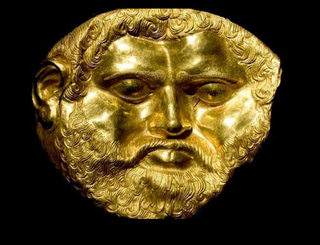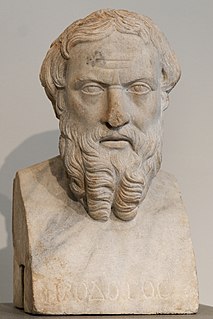The Bithyni were a Thracian tribe who, along with the Thyni, migrated to Anatolia. Herodotus, Xenophon and Strabo all assert that the Bithyni and Thyni settled together in what would be known as Bithynia and Thynia. According to Herodotus, the Bithynian Thracians originally lived along the Strymon river, and were known as Strymonians.

Agathyrsi were a people of Scythian, or mixed Dacian-Scythian origin, who in the time of Herodotus occupied the plain of the Maris (Mures), in the mountainous part of ancient Dacia now known as Transylvania, Romania. Their ruling class seems to have been of Scythian origin.

The Satrae were, in ancient geography, a Thracian people, inhabiting part of Mount Pangaeus between the rivers Nestus (Mesta) and Strymon (Struma).

In antiquity, Paeonia or Paionia was the land and kingdom of the Paeonians (Παίονες).

The Odrysian Kingdom was a state union of over 40 Thracian tribes and 22 kingdoms that existed between the 5th century BC and the 1st century AD. It consisted mainly of present-day Bulgaria, spreading to parts of Southeastern Romania, parts of Northern Greece and parts of modern-day European Turkey.

The Getae, , or Gets were several Thracian tribes that once inhabited the regions to either side of the Lower Danube, in what is today northern Bulgaria and southern Romania. Both the singular form Get and plural Getae may be derived from a Greek exonym: the area was the hinterland of Greek colonies on the Black Sea coast, bringing the Getae into contact with the ancient Greeks from an early date. Several scholars, especially in the Romanian historiography, posit the identity between the Getae and their westward neighbours, the Dacians.

Teres I, was the first king of the Odrysian state of Thrace. Thrace had nominally been part of the Persian empire since 516 BC during the rule of Darius the Great, and was re-subjugated by Mardonius in 492 BC.

The Bessi were an independent Thracian tribe who lived in a territory ranging from Moesia to Mount Rhodope in southern Thrace, but are often mentioned as dwelling about Haemus, the mountain range that separates Moesia from Thrace and from Mount Rhodope to the northern part of Hebrus. Herodotus described them as a sort of priestly-caste among the Satrae, the Bessi being interpreters of the prophetic utterances given by a priestess in an oracular shrine of Dionysus located on a mountain-top.

Apsinthii is the name of a Thracian tribe mentioned by Herodotus. The Apsinthii were located east of the Dolonci, another Thracian tribe, and on Chersonesos. It was due to them that Miltiades erected a wall from Cardia to Pactye.

Dolonci or Dolonki is the name of a Thracian tribe in Thracian Chersonese. They are mentioned by Herodotus.

The history of Thracian warfare spans from the 10th century BC up to the 1st century AD in the region defined by Ancient Greek and Latin historians as Thrace. It concerns the armed conflicts of the Thracian tribes and their kingdoms in the Balkans. Apart from conflicts between Thracians and neighboring nations and tribes, numerous wars were recorded among Thracian tribes.

Odomanti or Odomantes were an ancient Thracian tribe. Some regard it as Paeonian, while others claim, that the tribe was with certainty Thracian. The Odomanti are noted by Herodotus, Thucydides, Stephanus of Byzantium and Pliny the Elder.
Thracian clothing refers to types of clothing worn mainly by Thracians, Dacians but also by some Greeks. Its best literal descriptions are given by Herodotus and Xenophon in his Anabasis. Depictions are found in a great number of Greek vases and there are a few Persian representations as well. In contrast to shapes and patterns we have very little evidence on the colours used.
Krobyzoi is a Thracian, Getae or Dacian tribe.

Nipsai or Nipsaioi is the name of a Thracian tribe. They are mentioned by Herodotus.

Paiti is the name of a Thracian tribe.
Pleistoros was, according to Herodotus, a Thracian god adored by the Gauls and the tribe "Absinthe" as the god of war. According to Josephus Flavius (in his Antiquities of the Jews, XVIII, 22, Pleistoros was the god of war Dacians pleistoi, to which these Thracians offered sacrifices of men. The priests were recruited between nobles, some of whom are warriors..










